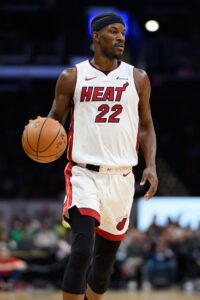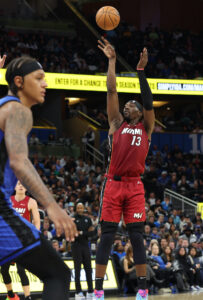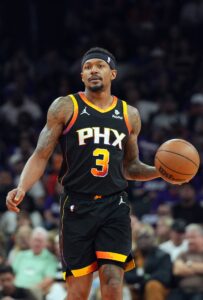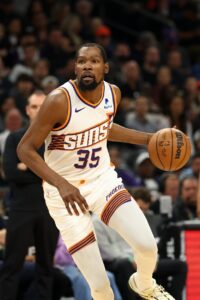Entering opening night last fall, the Heat were coming off one of the most unusual seasons in recent memory. They barely finished above .500 during the 2022/23 regular season, posting a negative net rating (-0.5) across 82 games, then narrowly survived the play-in tournament to earn the No. 8 spot in the Eastern Conference playoffs. From there, they knocked off the Bucks, Knicks, and Celtics in their first three postseason series, coming within three wins of a championship before ultimately falling to Denver.
During the subsequent 2023/24 season, Erik Spoelstra repeatedly insisted that his team wasn’t counting on a repeat of the year before and was taking the regular season seriously rather than waiting to turn it on in the postseason. But injuries and inconsistency resulted in a pretty similar outcome. Miami won 46 games instead of 44 and outscored its opponents, but once again finished in the bottom half of the league in net rating and needed a win in its second play-in game to grab the No. 8 playoff seed.
This time around, there was no postseason magic for the Heat, who were missing star Jimmy Butler due to a knee injury and managed just a single win over the top-seeded Celtics before their season came to an unceremonious end.
On one hand, the Heat are just one year removed from winning the East and perhaps could have made a deeper run this spring with a healthy Butler and a more favorable first-round matchup. But that’s a rosy view of their situation. The regular season results show that this team has been a relatively middle-of-the-pack squad over the past two seasons and, with Butler entering his age-35 season, probably can’t consider itself a legitimate title contender without some tweaks to the roster.
Based on what’s transpired since their season ended (more on that below), I wouldn’t rule out major offseason changes for the Heat, but it’s not in their DNA to fully rebuild (they haven’t won fewer than 37 games since 2007/08). So even if next season’s roster looks quite a bit different than the ’23/24 group, the goal will be to get further in the 2025 playoffs than they did this year.
The Heat’s Offseason Plan
 The most pressing question facing the Heat this summer is whether or not Butler will still be on the roster on opening night. A breakup would be a bit of a surprise, given that the past five years have seemed like a near-perfect marriage between one of the NBA’s most competitive stars and a franchise that prides itself on its hard-working culture.
The most pressing question facing the Heat this summer is whether or not Butler will still be on the roster on opening night. A breakup would be a bit of a surprise, given that the past five years have seemed like a near-perfect marriage between one of the NBA’s most competitive stars and a franchise that prides itself on its hard-working culture.
But shortly after the Heat’s season ended, word broke that Butler would be seeking another maximum-salary extension this summer, looking to replace his 2025/26 player option with a new two-year deal worth approximately $113MM. Asked at his end-of-season press conference about that possibility, longtime team president Pat Riley didn’t explicitly say whether or not the Heat would be willing to put that offer on the table, but suggested they wouldn’t exactly be eager to do so.
“It’s a big decision on our part to commit those kinds of resources, unless you have someone who is going to be available every night,” Riley said, referring to an injury history that has forced Butler to miss at least 15 games in every season since he arrived in Miami in 2019.
Riley also didn’t approve of a viral video that showed Butler claiming the Heat would’ve been able to beat Boston and New York if he’d been available to play in the postseason. The Heat president told reporters, “If you’re not on the court playing against Boston or on the court playing against the New York Knicks, you should keep your mouth shut on the criticism of those teams.”
A thinner-skinned player might respond to those comments by submitting a trade request, but the ability to be frank and honest with one another is an important reason why the relationship between Butler and the Heat has worked. I wouldn’t expect him to seek a change of scenery this offseason due to hurt feelings. But if Miami is unwilling to put an appealing extension offer on the table this summer, he might become more inclined to weigh all his options as he enters the final stage of his career.
While the Heat would be under no obligation to move Butler if he asked to be traded, he showed earlier in his career in Minnesota that he can make life difficult for his current team if his demands aren’t met. Still, I’m not necessarily counting on the situation coming to a head this offseason. Miami would have a hard time turning Butler into a player – or multiple players – who could increase the club’s ceiling in 2024/25, and the 34-year-old has been in the league long enough to know that the grass isn’t always greener in a new environment.
Three-time All-Star center Bam Adebayo will also be extension-eligible this summer and looks like a better bet than Butler to get a maximum-salary offer from the Heat, given his edge in age (27 in July) and availability (he has missed more than 11 games just once in the past five seasons). A max deal for Adebayo would be worth approximately $165MM over three years. He could potentially become eligible for more years and more money with an All-NBA berth or a Defensive Player of the Year trophy next summer, but I could see the big man opting to lock in that long-term guaranteed money now.
If building around Butler and Adebayo remains the plan going forward, I’d expect some combination of Tyler Herro ($29MM), Terry Rozier ($24.9MM), and Duncan Robinson ($19.4MM) – and perhaps all three – to be mentioned in trade rumors this summer. As long as they’re able to operate below the second tax apron, the Heat would be permitted to aggregate those salaries in a trade for another star, and the franchise has made a habit of going star-hunting over the years, including in the 2023 offseason when its bid for Damian Lillard came up short.
Cleveland (Donovan Mitchell, Darius Garland) and Atlanta (Trae Young, Dejounte Murray) are among the situations the Heat figure to keep an eye on this offseason, with Mitchell in particular having long been considered a prime target.
If Mitchell or another well-fitting impact player hits the trade market, it’s possible a rival suitor would outbid Miami, like the Bucks did last year with Lillard. But the team has some strong trade assets, including All-Rookie first-teamer Jaime Jaquez, 21-year-old forward Nikola Jovic, this year’s No. 15 overall pick, and at least one future first-rounder — the Heat have traded away their 2025 and 2027 first-rounders, but protections could push those picks back to 2026 and 2028, so only the ’30 pick can be traded unconditionally, though the club could offer a handful of first-round swaps.
The more prudent approach to the offseason might be to keep those youngsters, who are on team-friendly contracts for multiple years, trust the scouting department to find another potential gem at No. 15, and perhaps attempt to make a less significant move involving one of Herro, Rozier, or Robinson. There’s a good deal of overlap in that trio — both Herro and Robinson provide most of their value with floor-spacing and outside shooting, while both Herro and Rozier are score-first guards – so if the Heat could find a way to turn one of them into more of a two-way wing or a traditional point guard, it would help balance the roster.
The Heat will have a sizable hole to fill on the wing if they’re unable to re-sign Caleb Martin, who is expected to turn down a $7.1MM player option, and Haywood Highsmith, who is headed for unrestricted free agency. Both players are due for raises and could be targeted by teams who have the full mid-level exception available.
The situation with those two players feels awfully reminiscent of the one the club faced with Max Strus and Gabe Vincent a year ago, when luxury tax concerns limited what Miami was able to offer that free agent duo. Strus ultimately agreed to join the Cavaliers, while Vincent signed with the Lakers.
The Heat already have over $163MM in guaranteed money on their books for seven players in 2024/25, and that figure would rise by another $14MM+ if Kevin Love, Josh Richardson, and Thomas Bryant exercise their player options and the team hangs onto its first-round pick. That would push team salary above $177MM, essentially assuring the Heat will operate over the first tax apron ($178.7MM) even without new deals for Martin or Highsmith.
Retaining either player would likely increase team salary beyond the $189.5MM second apron, so Miami will have a decision to make. It can resign itself to losing two solid role players for a second straight summer, try to shed salary elsewhere to create room under the second apron to bring back Martin and/or Highsmith, or simply re-sign both players and commit to being a second-apron team, accepting the roster-building restrictions that come with that.
None of those options are ideal, and the third one seems especially unlikely, given that the Heat will want to maintain the flexibility to aggregate salaries if a star becomes available. I expect the club to explore the second path in an effort to retain at least one of those two free agents, but if that’s not possible, Heat fans can at least take solace in the fact that the front office has done a good job over the years finding low-cost replacements to fill out the rotation when certain role players get too expensive.
The Heat will also benefit from the fact that there’s never a shortage of veterans who want to play in Miami due to a combination of the weather, the culture, and the organization’s distaste for rebuilding. Richardson missed half the season due to an injury and Bryant wasn’t quite as good a fit as the front office had hoped, but those are high-quality players for the minimum-salary tier, as is Love. Whether or not those guys opt in to return for another season, the Heat will likely head back to the free agent market in search of more minimum-salary bargains to fill out the back end of their roster.
Salary Cap Situation
Guaranteed Salary
- Jimmy Butler ($48,798,677)

- Bam Adebayo ($34,848,340)
- Tyler Herro ($29,000,000)
- Terry Rozier ($24,924,126)
- Duncan Robinson ($19,406,000)
- Jaime Jaquez ($3,685,800)
- Nikola Jovic ($2,464,200)
- Total: $163,127,143
Non-Guaranteed Salary
- Orlando Robinson ($2,120,693)
- Robinson’s salary will become guaranteed if he remains under contract through July 15.
- Total: $2,120,693
Dead/Retained Salary
- None
Player Options
- Caleb Martin ($7,126,900): Bird rights
- Kevin Love ($4,027,525): Early Bird rights
- Josh Richardson ($3,051,153): Non-Bird rights
- Thomas Bryant ($2,845,342): Non-Bird rights
- Total: $17,050,920
Team Options
- None
Restricted Free Agents
- None
Two-Way Free Agents
Note: Because he has finished each of the past two seasons on a two-way contract with the Heat, Cain’s qualifying offer would be worth his minimum salary (projected to be $2,093,637). That offer would include a small partial guarantee.
Draft Picks
- No. 15 overall pick ($4,244,160 cap hold)
- No. 43 overall pick (no cap hold)
- Total (cap holds): $4,244,160
Extension-Eligible Players
- Bam Adebayo (veteran)
- Jimmy Butler (veteran)
- Haywood Highsmith (veteran)
- Extension-eligible until June 30.
- Caleb Martin (veteran)
- Player option must be exercised.
- Duncan Robinson (veteran)
- Terry Rozier (veteran)
Note: Unless otherwise indicated, these players are eligible for extensions beginning in July.
Unrestricted Free Agents
- Haywood Highsmith ($2,093,637 cap hold): Bird rights
- Patty Mills ($2,093,637 cap hold): Non-Bird rights
- Delon Wright ($2,093,637 cap hold): Non-Bird rights
- Total (cap holds): $6,280,911
Other Cap Holds
- Udonis Haslem ($2,093,637 cap hold)
- Jordan Mickey ($2,093,637 cap hold)
- Dwyane Wade ($2,093,637 cap hold)
- Total (cap holds): $6,280,911
Note: The cap holds for these players are on the Heat’s books from prior seasons because they haven’t been renounced. They can’t be used in a sign-and-trade deal.
Cap Exceptions Available
Note: The Heat project to operate over the cap and over the first tax apron. If they move below the first apron, they would gain access to the bi-annual exception ($4,681,000) and the full mid-level exception ($12,859,000) instead of the taxpayer mid-level exception and would regain access to their three trade exceptions (the largest of which is worth $9,450,000 and expires on July 8). If they surpass the second tax apron, they would lose access to the taxpayer MLE.
- Taxpayer mid-level exception: $5,183,000
 The moves left Phoenix with a top-heavy roster headed by three players who will earn a combined $150MM+ in 2024/25 when
The moves left Phoenix with a top-heavy roster headed by three players who will earn a combined $150MM+ in 2024/25 when 